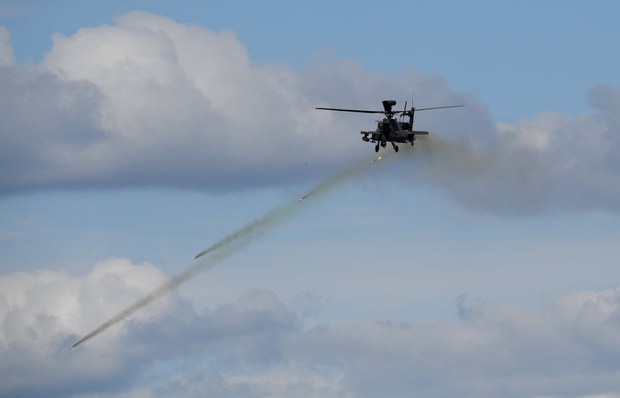US Moving to Sell 6 Attack Helicopters to Philippines
2020.05.01
Washington and Manila
 A South Korean AH-64E Apache helicopter fires rockets during a live-fire demonstration for a media preview of the Defense Expo Korea 2018, at Seungjin Fire Training Field in Pocheon, South Korea, Sept. 11, 2018.
A South Korean AH-64E Apache helicopter fires rockets during a live-fire demonstration for a media preview of the Defense Expo Korea 2018, at Seungjin Fire Training Field in Pocheon, South Korea, Sept. 11, 2018.
The U.S. State Department has approved a possible sale to the Philippines of military-helicopter packages ranging in price from U.S. $450 million to $1.5 billion, as the Southeast Asian ally looks to modernize its attack-helicopter fleet, officials in Washington said.
In Manila, the Philippine defense chief said he was aware of the announcement of the potential sale of U.S.-made Apache or Viper helicopters, but indicated that the Philippines was looking at other options for such military hardware because of the hefty price-tag.
“It was being considered by the PAF [Philippine Air Force] but it is so expensive they opted instead to consider other attack helicopters,” Defense Secretary Delfin Lorenzana told BenarNews via a text message late Friday.
He was referring to both helicopter packages included in the U.S. government’s announcement, when asked to confirm the potential deal. He did not elaborate.
On Thursday, the U.S. Defense Security Cooperation Agency (DSCA) announced that the State Department had cleared the potential sale to Manila of six AH-1Z Viper helicopters or six AH-64E Apache helicopters with other equipment and parts. The Philippines was considering acquiring either of the packages but not both, DCSA said in a news release.
“This proposed sale will support the foreign policy and national security of the United States by helping to improve the security of a friendly country that continues to be an important force for political stability, peace, and economic progress in South-East Asia,” the agency said.
The proposed transaction “will assist the Philippines in developing and maintaining strong self-defense, counterterrorism, and critical infrastructure protection capabilities,” it said.
The Viper package carries a price-tag of $450 million and the Apache package would cost $1.5 billion. The Philippines’ 2020 defense budget, which the country’s senate approved last November, is 191.3 billion pesos (U.S. $3.7 billion), according to Jane’s 360.
Either of the helicopter packages, the DCSA said, would be sold to Manila under the U.S. Foreign Military Sales program, a form of security assistance authorized by the U.S. Arms Export Control Act. Eligible countries can buy military equipment with their own funds or with funds disbursed through U.S.-government assistance programs, according to information on the DCSA’s website.
Through the program, Manila last year acquired eight ScanEagle aerial drones as part of a $47.9 million package of drones sold by Washington to the Philippines, Malaysia, Indonesia and Vietnam. At the time, officials in Manila and Kuala Lumpur said the drones would be used for aerial surveillance of local waterways, including the disputed South China Sea.
It was not immediately clear whether the helicopters in the potential sale would be used in the sea region, where the Philippines and China have contending territorial claims, or in the southern Philippines, where government forces are dealing with threats from Islamic State-linked militants.
Washington announced the possible sale of the helicopters amid relations with the Philippines that have been rocky lately.
Early this year, Philippine President Rodrigo Duterte threatened to pull his country out of a bilateral defense pact with the United States. He was angry that the U.S. State Department had revoked an American visa for his former national police chief, who had led his administration’s controversial and bloody war on illegal drugs.
On Friday, presidential spokesman Harry Roque declined to answer questions from BenarNews about the potential deal for the Apache or Viper helicopters.
Duterte’s government, meanwhile, has not withdrawn its threat to cancel the 1999 Visiting Forces Agreement (VFA).
The pact allows for joint military exercises and other activities between the two longtime allies after the United States vacated two of its largest overseas military installations – the Subic Bay Naval Base and Clark Air Base, both located northwest of Manila – in the 1990s.
The VFA bore fruit in 2017 when Philippine troops received aerial intelligence from U.S. forces during their successful battle against Islamic State militants who had taken over the southern city of Marawi for five months.
Jason Gutierrez in Manila contributed to this report.







